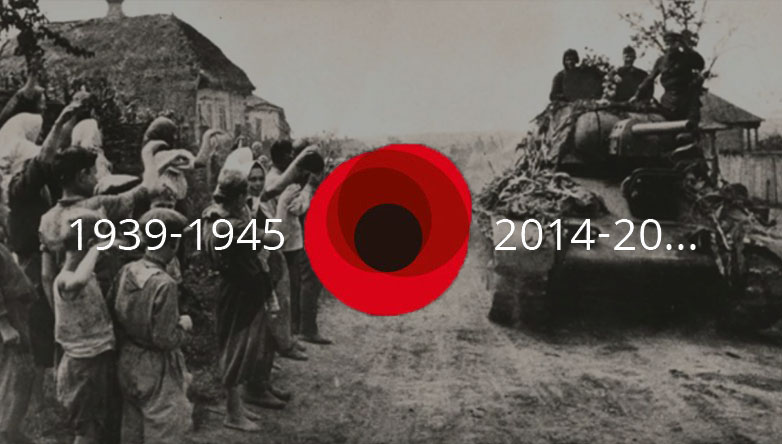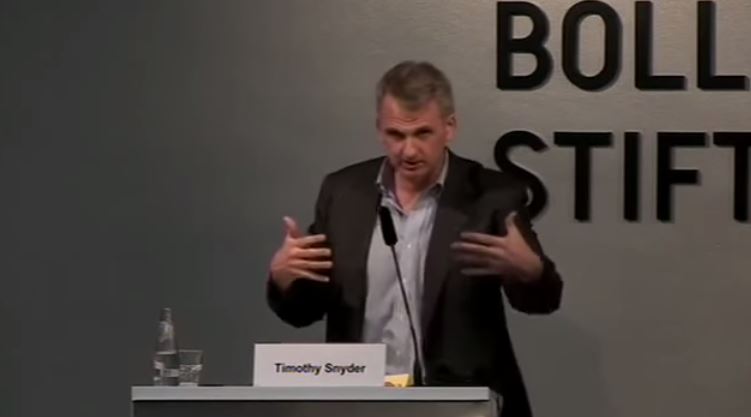We often can understand what is happening today by looking at history. However, in the hands of Russian advocates, history has become a convenient tool in the information war, used to legitimize the actions of the Kremlin and delegitimize the Ukrainian authorities.
If we analyze the speeches of Vladimir Putin, President of the Russian Federation, it is easy to see that he uses historical events in his rhetoric. In this, he is similar to another aggressor – Adolf Hitler. Both politicians represent their military expansion and the annexations of neighboring territories in the guise of restoration of historical justice; both justified their interference in the internal affairs of a neighboring state as a way of protecting their fellow countrymen (countrymen in English can only mean citizens of the same country) – whether this was in the Sudentenland or in the Donbas.
In the Kremlin’s large-scale propaganda campaign, aimed at citizens of the Russian Federation, ethnic Russians living in Ukraine and at the international community, numerous historical myths are used, many of which originated in the times of the Russian Empire and the Soviet Union. The first category of these basic myths included the idea that the Ukrainian people never existed. Today, the outright denial of the existence of the Ukrainian people is used by the pro-Kremlin nationalist forces in Russia. For them, the very existence of a Ukrainian state is a geopolitical mistake that should be rectified. But this argument is implicitly present in the official Russian propaganda that justifies its intervention in the internal affairs of neighbouring countries in order to protect Russians (or Russian speakers).
Obviously modern Russian propaganda uses Soviet historical myths and stereotypes, because deconstruction has not taken place neither in the minds of Ukrainians nor, especially, of Russians after the collapse of the Soviet Union. Soviet historical myths are one of the main pillars of Soviet identity. And Russian aggression against Ukraine today relies on the carriers of this identity: not the Russian speaking Ukrainians nor ethnic Russians, whom Putin is supposedly protecting, but rather those Soviet people (homo sovieticus) who are the only ones supporting his actions. The Donbas has the greatest number of these because of various reasons: historical (mass political repression and the Holodomor, the artificial famine of 1932-33) and socio-economic (preserved Soviet industry and structure of society).
Central in the post-war Soviet ideology is the memory of the Second World War which is presented as the Great Patriotic War. Victory Day became a major national holiday. This holiday gradually pushed even November 7th (the anniversary of the October Revolution) into the background and became the first and most important holiday for Soviet communists. The war itself, presented as the Great Patriotic War, is seen as the cornerstone of the nation-forming myth of the USSR. Its purpose was to serve as the basis for a pan-Soviet identity in a Soviet perspective. Its cornerstones were the idea of mass patriotism and sacrifice in the name of the Soviet Motherland, an unprecedented mobilization of the “Soviet” people in the fight against a terrible threat, and the messianic campaign for the liberation of Europe. The great victory, the last chord of this powerful myth, allegedly occurred because of the course chosen by the Soviet leadership and demonstrated the power and infallibility of the communist regime.
Preparation for this myth’s entrenchment took place in the 1920s-1930s: those who did not fit the image of the “Soviet man” and thought for themselves were massively liquidated. This new myth was perfected during the first months of the war. Millions of soldiers who did not want to defend the USSR as they did not see it as their motherland were captured and subsequently killed either by the Germans or the Soviets. They were replaced by a new generation that was much more influenced by Soviet propaganda and who did not remember the horrors of the previous decade and the disaster of the first days of the war. In addition, these people also saw the real horrors of the Nazi occupation and therefore did not believe in liberation by the Germans. Given the eventual collapse of the German regime and the inevitable victory of the Reds, the total number of citizens loyal to Soviet power steadily increased to far beyond pre-war figures.
The circumstances of the war years created ideal conditions for forming a new Soviet identity. Millions of people from different nationalities were in the Red Army and were forced to speak the same language, were cut off from the outside world, and their daily routine was handled by the political commissar who helped form their new Soviet consciousness with new Soviet values. The horrible shared experiences as well as the constant fluctuating between life and death, the presence of a common enemy which repeatedly demonstrated its inhuman nature, and a sense of a shared mission created the best conditions for this task. The army became the melting pot of people of different nations which had to unite as one Soviet people. And it did partially fulfill its task. Today, years after the fall of the Soviet Union, the war veterans are the most consolidated and articulated pro-Soviet group in any post-Soviet society.
The “Great Victory” myth has continued to live after the fall of the USSR. In each of the former republics and now independent countries, May 9th is regularly celebrated. On the 60th anniversary of the war, the commemoration which took place in Moscow in 2005 showed that, for the Russian leadership, it was not just a tribute to tradition or historical inertia. The “Great Victory” once again became the central provision of the new state ideology of the Kremlin.
A diplomatic scandal ensued because Russia was protecting its “sacred memory of Victory,” and mercilessly criticized all attempts to revise these outdated Soviet concepts of the war. There was extensive use of films, television and literature to propagate the Soviet myths about the war which would keep the former Soviet republics in Russia’s influential orbit. A joint historical past is a platform for creating (or maintaining) a strong pro-Russian lobby in independent states.
The presence of these myths in the public consciousness is what Russian propaganda is trying to use to its fullest. As it is presented today, the war with Ukraine is not an act of aggression against a neighboring state, but rather a struggle against the fascists who threaten Russia and the world. To enhance this impact, terminology from Soviet Second World War propaganda is used. The Ukrainian military is called “karatieli”(“punitives”) – this was how the soldiers in the German army were called; while their own army is called “opolchentsy” (“militiamen”), a word which appeals to the myth of the Soviet people’s resistance to German invaders. People working with the Ukrainian authorities are called “posobniki” (“accomplices”) – a term that was used for collaborators during the Second World War. The tragic fire in Odesa on May 2nd 2014 was called a “Hatyn” – a name of a Belorussian village burned by the Nazis. And of course, one of the most frequently used epithets is “banderovtsy” (“Banderites”) – a word Soviet propaganda used during the war to describe members of the Ukrainian liberation movement. They are portrayed as traitors and collaborators guilty of war crimes. These stereotypes are significant in the minds of the inhabitants of the former Soviet Union, even after refutation through documents and studies.
Many people in Ukraine and Russia believe this propaganda and take up arms. Their symbol is the so-called “St. George Ribbon,” which was used in Soviet awards – the Order of Glory and the medal For Victory over Germany. They seem to have become like the heroes of Soviet movies about the Great Patriotic War – these are the horrible fascists and the Soviet good guys confront them. But in this game of war today, they pay with their lives.
In the Donbas where the war continues, the Soviet myths about the Second World War have been entrenched. Moreover, after the collapse of the Soviet Union, they have become one of the key elements of the Donbas inhabitants’ modern identity. The communist ideology has now compromised itself, and the national-democratic majority aren’t accepted here. Local political elites have sought ideological constructs that could work in the Donbas context: here they found the Soviet myth of the “Great Patriotic War” and the “Great Victory” very useful. Historians’ attempts to deconstruct these myths after the collapse of the Soviet Union did not have a significant impact on the local population. On the contrary, prevailing pro-Russian moods have led to a very successful Russian propaganda campaign restoring these myths. Various anniversaries related to war (Victory Day, the Day of the Soviet Partisan, Great Patriotic War Day, Liberation Days), Soviet in content and form, the inauguration of monuments to Soviet war heroes – all of this was implemented with the support of local authorities, even under President Yushchenko who was known for his anti-Soviet stance. After winning the 2010 election, Viktor Yanukovych, a representative of the Donbas, brought these practices to the national level.
The Soviet myths about the Second World War used the cult of war and militarism. Since it was in the Donbas where the strongest of these were rooted Thereby, in 2014, many local people were not merely ready for military confrontation – they wanted it. Only after war really came to these lands did many people changed their views on what war actually was.
The myths about the Second World War are used by Russian propaganda not only in Ukraine or Russia but also in Europe. Russia monopolizes the victory of the Red Army over fascism, even though the Red Army ranks were filled with millions of Ukrainians and other nationalities. According to the Russian leadership, this victory is relevant to our time: “we cannot be the aggressor, because we liberated the world from Hitler.”
Not knowing Ukrainian history, experts and journalists believe the mythical threat of Ukrainian fascism because on the Maidan or among the Ukrainian soldiers in the east the flag of Bandera is flown. Unfortunately, the history of Bandera – who was imprisoned in a Nazi concentration camp, became a target of Soviet propaganda and finally a target of the KGB who assassinated him in 1959, is as little known as the movement he headed. The members of this movement, after a period of cooperation with the Third Reich in 1939-1941, launched a large-scale anti-German partisan campaign towards the end of 1942. One could not write about this war during Soviet times because the Soviet Union was the only anti-fascist state, and any anti-fascist opposed to Stalin had to be, therefore, a fascist. There is a similar division of the world today according to Russian propaganda: the leading representative of anti-fascism is Putin. The only fascists left are those Ukrainians who disagree with Russia’s policy.
Therefore, modern Russian propaganda is actively using Soviet historical myths not only to form or maintain their understanding of the past, but to influence the present and future deformation of their Soviet past.
[hr]Other proceedings from the conference "Usage of the topic of WWII in the Russian political discourse":
Memory of the Great Patriotic war in Russia’s expansionist policy
Occupation of Crimea repeats Latvia’s occupation by USSR
The “Great Patriotic War” as a weapon in the war against Ukraine
Russian media operates by law of war, tapping into Great Patriotic War myth
Soviet myths about World War II and their role in contemporary Russian propaganda






